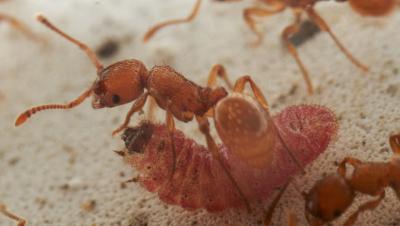Parasitic butterfly larvae may mimic ants' acoustic signals to aid in the infiltration of their host colonies, according to results published April 9, 2014, in the open access journal PLOS ONE by Marco Sala from University of Turin, Italy, and colleagues.
Ants aggressively defend their colonies and nests, so successfully that these locations make a perfect shelter for another similar species to live in. However, ants have evolved a complex set of signals that allow colony members to distinguish between residents and intruders. The social parasitic Maculinea butterfly uses chemical and acoustic adaptations to trick ant signaling defenses, and manages to spend most of its life cycle inside the ant nest. To better understand the potential role of acoustic signals in butterfly larvae integration and adoption by ant colonies, scientists compared two populations of parasitic butterflies: a predatory species that feeds on ant broods, and a cuckoo species that is fed directly by the worker ants. The eggs of both species are laid on the outside of the colony and then eventually adopted by the ants.
Researchers recorded and analyzed acoustic emissions from butterfly larvae pre- and post-adoption by the ant colony and from worker and queen ants. They then played sounds and observed the ants' behavior.
In the first recording experiment, the authors found that butterfly larval acoustic emissions were more similar to those of queen ant than those of worker ants, although the larval acoustic sounds varied between and within butterfly species. Playback experiments showed ant workers responding the most strongly to sounds from post-adopted cuckoo larvae and from predatory larvae sounds recorded pre-adoption.
These results suggest acoustic signals may play a role in parasite integration and adoption into the colony.

Parasitic butterfly larvae may use acoustic signals to infiltrate ant colonies.
(Photo Credit: Luca P. Casacci)




Comments